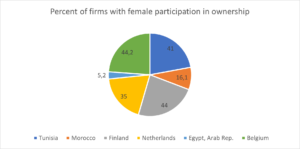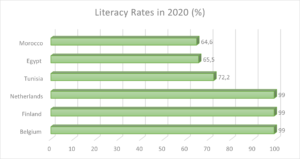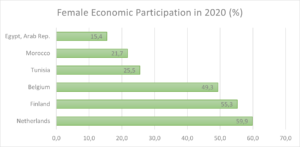Female entrepreneurship as a sign of women’s empowerment
Female entrepreneurship in developing vs. developed countries
Studies have shown that empowering women to participate equally in the global economy could add up to $28 trillion in GDP growth by 2025. Many global indicators can be used to assess the level of women’s empowerment across developed and developing economies. Observing the growth in the number of female entrepreneurs is a great sign of women’s empowerment. The more women have access to equal opportunities, the more developed a country can be, and the easier it is to reduce any existing inequalities that can slow down the economic growth of a nation. To determine disparities in female entrepreneurship, 2020 data from the World Bank was used to compare the number and characteristics of firms among benchmark countries using the share of female entrepreneurship among the firms surveyed. The countries chosen for this observation are Egypt, Tunisia, Morocco, the Netherlands, Belgium, and Finland to show where developing countries stand in comparison to more developed countries.
As shown in the pie chart below, Finland and Belgium, both developed economies, appear to have the highest number of firms with female participation in ownership. On the contrary, Egypt has the lowest number of firms with female participation in ownership. The World Bank Enterprise survey shows that 44.2% of firms surveyed in Finland are owned by women, compared to 5.2% of firms surveyed in Egypt. These results show the disparities in the progress made toward the empowerment of active females in the labor market. Another important point to note is the fact that Egypt, Tunisia, and Morocco all have lower shares of female entrepreneurship compared to Finland, the Netherlands, and Belgium. In other words, it can be pointed out that economic and social development play a vital role in increasing the number of female entrepreneurs and encouraging more women to start their own business ventures.
Figure 1: Percentage of firms surveyed with female owners

In many areas, women lack access to an entrepreneurial environment, social and institutional support, equal educational opportunities, and financial support programmes. Digging deeper, the literacy rates in the selected countries can show the knowledge and human capital gap between developed and developing countries.
Figure 2: % of females who can both read and write

Based on that, education levels and enrollment rates directly impact women’s economic participation rates. This can be seen in the graph below:
Figure 3: Female Labor Force Participation Rates

The idea here is to show the correlation between female entrepreneurship, education levels, and labor force participation rates. The two chosen indicators prove the positive relationship between education, female labor force participation rates, and female entrepreneurship. This highlights the importance of policies aimed at increasing literacy rates and female economic participation, which can eventually help reduce the gender gap in entrepreneurship rates in both developed and developing countries.
Lessons to learn from policies implemented in developed countries
As a result of more women joining the workforce, public policy has focused on supporting women’s entrepreneurship since the 1970s. Since then, both developed and developing nations have adopted common policies and programmes aimed at promoting women’s entrepreneurship. Despite substantial improvements in aiding women to overcome barriers to starting their own enterprises and working for themselves, women continue to face challenges, demanding further and more inclusive public policy action.
Developing countries can observe and track effective policies implemented in developed countries that would enable the increase of female economic participation and, more importantly, female entrepreneurship. The gender gap in entrepreneurship can be reduced with the presence of profound measures and support programmes targeted at encouraging women’s economic participation. Examples of successful policies include:
- Finland: The Equality Programme includes providing loans to small companies, counseling, training, and establishing an entrepreneurs’ mutual assistance network. This draws attention to the importance of access to finance for women entrepreneurs.
- European Union: The European Union’s structural funds support numerous initiatives promoting women’s employment. For instance, the Structural Funds’ programmes aim to encourage female entrepreneurs, keep unemployed people engaged in the workforce, make it easier for people to re-enter the workforce, and enhance skills.
- European Union: The Entrepreneurship 2020 Action Plan calls for awareness-raising, entrepreneurship training, improved access to financing, stronger networks, and support in reconciling business and family life. The Programme revolves around 3 pillars: investing in entrepreneurial education, reducing financial burdens by improving access to finance, and recognizing and providing awards to role models.
- Sweden: The ‘Women Ambassadors’ scheme was set up to (i) increase the visibility of female entrepreneurship; (ii) inspire female entrepreneurship through personal stories and role models;(iii) make it easier for women to identify with entrepreneurial role models; (iv) encourage more women to view entrepreneurship as a potential career; and (v) help women address their entrepreneurial challenges by sharing their experiences. The programme ambassadors have reached more than 170,000 women in approximately 11,000 activities. The survey of the programme’s participants and ambassadors has shown that the participants had more interest in entrepreneurship after meeting an ambassador.
- Belgium: Young Company initiative aims to give students experience that closely resembles managing a business in the real world. The concept is built on the foundation of a joint-stock firm. This gives young people the chance to work in a variety of firm positions, including those of director and HR manager, among others. Young Company aims to reach children in secondary schools.
Currently, policies related to women’s empowerment are not sufficient to overcome the low levels of female entrepreneurship in developing countries. It is also worth noting that allowing women to engage in growth possibilities will help developing nations speed up their economic and social development.
Around the world, female business owners significantly contribute to economic growth and the eradication of poverty. Women-owned businesses, for instance, are growing more than twice as quickly as all other businesses in the United States, contributing close to $3 trillion to the national economy and directly supporting 23 million job opportunities. Progress is also taking place in developing countries, where there are between 8 million and 10 million formal small and medium enterprises (SMEs) with at least one female owner, and this number is rising. Studies have also shown that eliminating gender disparities in the workforce could increase the global GDP by 26%, benefiting both developed and developing nations.
Globally, women continue to face significant obstacles that hinder the growth of their businesses, such as a lack of capital, strict social constraints, and limited time and skill. Despite the increase in education and school enrollment among women, they tend to lack the combination of education, vocational training, and skills required to promote the growth of highly productive firms. Regarding access to finance, the World Bank showed that 190 million fewer women than men own bank accounts.
Therefore, achieving women’s empowerment is a vital step toward reducing gender inequalities and ensuring equal access to opportunities for all. Both the private and public sectors should create incentives to encourage investments in women-owned businesses to help accelerate women’s entrepreneurship. Reforms and policies that promote and encourage women’s entrepreneurship and economic participation should also be more common to achieve economic growth and reduce the global gender gap. More training programmes should be available for women who wish to start their own business ventures, allowing them to accumulate the managerial, financial, and technical skills needed to adapt to a business environment driven by technological advances.
Author: Hebatallah Mohamed
References:
World Economic Forum: https://www.weforum.org/agenda/2018/01/this-is-why-women-must-play-a-greater-role-in-the-global-economy/
World Bank Enterprise Survey: https://www.enterprisesurveys.org/en/enterprisesurveys
Labor Force Participation Rates: https://data.worldbank.org/indicator/SL.TLF.TOTL.FE.ZS?locations=EG
Global Gender Gap Report 2020 – The World Economic Forum: https://www3.weforum.org/docs/WEF_GGGR_2020.pdf
Equality Programme of The Finnish Government: https://www.un.org/womenwatch/confer/beijing/national/finisnap.htm
European Commission Entrepreneurship2020 Action Plan : https://www.eesc.europa.eu/sites/default/files/resources/docs/entrepreneurship2020—action-plan.pdf
Women Ambassadors, Sweden: https://betterentrepreneurship.eu/en/content/women-ambassadors-sweden?q=/printpdf/919
Entrepreneurship education in Belgium: https://www.schooleducationgateway.eu/downloads/entrepreneurship/Belgium_151022.pdf
Female Entrepreneurship Resource Point – Introduction and Module 1: Why Gender Matters: https://www.worldbank.org/en/topic/gender/publication/female-entrepreneurship-resource-point-introduction-and-module-1-why-gender-matters
Council on Foreign Relations: https://www.cfr.org/womens-participation-in-global-economy/
You may also like
Warning: Undefined variable $content in /var/www/sdomains/nexatestwp.com/infomineo.nexatestwp.com/public_html/wp-content/themes/infomineo/single.php on line 235
Warning: Undefined variable $content in /var/www/sdomains/nexatestwp.com/infomineo.nexatestwp.com/public_html/wp-content/themes/infomineo/single.php on line 235
Warning: Undefined variable $content in /var/www/sdomains/nexatestwp.com/infomineo.nexatestwp.com/public_html/wp-content/themes/infomineo/single.php on line 235
Warning: Undefined variable $content in /var/www/sdomains/nexatestwp.com/infomineo.nexatestwp.com/public_html/wp-content/themes/infomineo/single.php on line 235
Warning: Undefined variable $content in /var/www/sdomains/nexatestwp.com/infomineo.nexatestwp.com/public_html/wp-content/themes/infomineo/single.php on line 235
Warning: Undefined variable $content in /var/www/sdomains/nexatestwp.com/infomineo.nexatestwp.com/public_html/wp-content/themes/infomineo/single.php on line 235
Warning: Undefined variable $content in /var/www/sdomains/nexatestwp.com/infomineo.nexatestwp.com/public_html/wp-content/themes/infomineo/single.php on line 235
Warning: Undefined variable $content in /var/www/sdomains/nexatestwp.com/infomineo.nexatestwp.com/public_html/wp-content/themes/infomineo/single.php on line 235
Warning: Undefined variable $content in /var/www/sdomains/nexatestwp.com/infomineo.nexatestwp.com/public_html/wp-content/themes/infomineo/single.php on line 235
Warning: Undefined variable $content in /var/www/sdomains/nexatestwp.com/infomineo.nexatestwp.com/public_html/wp-content/themes/infomineo/single.php on line 235












